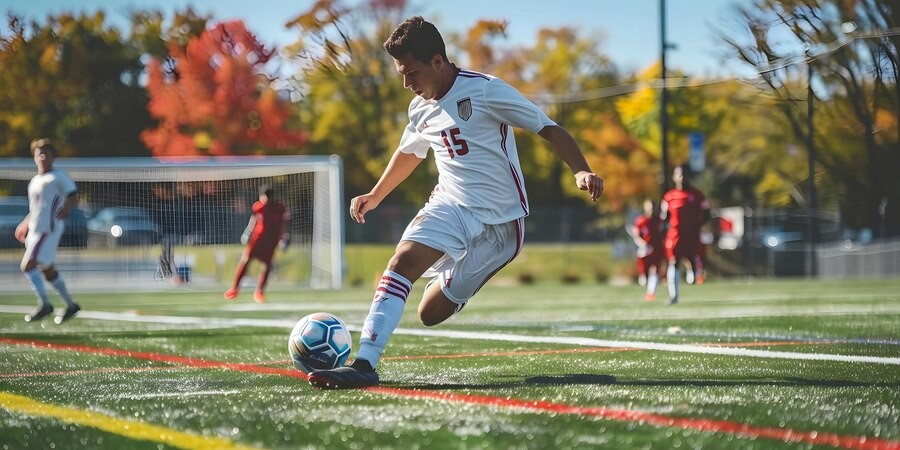The Evolution of College Soccer: Recent Trends to Watch

Table of Contents
ToggleFuture Outlook for College Soccer
College soccer has experienced significant growth and transformation over the last few decades, reflecting wider sports, education, and youth culture changes. With the increasing popularity of soccer in the United States, the collegiate level has emerged as a crucial phase for developing future professional players. This blog explores recent trends in college soccer, examining the evolving dynamics that impact players, coaches, and fans alike. From the rise in international recruitment to the impact of technology on training and scouting, here’s an in-depth look at the forces shaping college soccer today.
1. The Growing Popularity of Soccer in the U.S.
Soccer, once considered secondary to American football, basketball, and baseball in the U.S., has steadily gained a larger audience. The rise of Major League Soccer (MLS) and the success of the U.S. Women’s National Team have driven youth participation in soccer, creating a more significant interest in the college game. Colleges now have greater support from alumni and fans, creating an atmosphere where student-athletes are motivated and college programs are incentivized to elevate the quality of the sport.
Key Takeaways:
- Increased attendance at college games, leading to more funding and scholarships.
- More college teams investing in facilities and coaching to stay competitive.
- Greater visibility for athletes and programs, increasing post-college career options.
2. Increasing Pathways to Professional Leagues
For decades, college soccer served as one of the only avenues for U.S.-based players to transition into professional leagues. However, today, college soccer is just one part of a diverse ecosystem for aspiring pros. The emergence of academy systems run by MLS teams has introduced alternative paths to professional leagues for talented youth players.
Nonetheless, college soccer still plays an essential role for players not picked up by academies or those who want a college education alongside their athletic pursuits. In response, the NCAA has adjusted its eligibility rules, allowing greater flexibility for athletes transitioning between college and pro leagues.
Key Takeaways:
- College soccer remains a valuable platform for players seeking a balanced college education and career training.
- Collaborative efforts with pro leagues, such as “draft rights” and “homegrown” player status, provide smoother transitions to professional soccer.
3. The Rise of International Talent in College Soccer
The recruitment of international players has added a unique flavor to the U.S. college soccer scene. Many American colleges are increasingly scouting overseas for talent, bringing in players from countries with deep soccer traditions. This influx of international athletes has not only diversified college soccer rosters but also enhanced the level of play and competition. The presence of international players introduces different styles of play and enriches the learning experience for American players.
Key Takeaways:
- U.S. college soccer teams benefit from diverse playing styles and experiences, leading to an increase in skill level.
- International players receive valuable education and exposure to the American sports system.
- Recruiting international talent encourages American players to raise their competitive standards.
4. Emerging Role of Data and Analytics
Data analytics has revolutionized how teams evaluate performance and strategize gameplay. From video analysis to wearable technology, college coaches now have access to tools that provide real-time data on players’ physical and tactical performance. Coaches and players can dissect game footage and monitor critical metrics such as speed, endurance, and positioning.
The increased focus on analytics allows teams to prepare with higher precision, analyze opponents more accurately, and tailor individual training to each player’s needs. This shift toward data-driven decision-making mirrors trends in professional soccer leagues and is a step toward making college soccer more competitive globally.
Key Takeaways:
- Wearable tech enables real-time tracking of player statistics for personalized feedback.
- Video analysis software enhances team preparation and in-depth analysis of gameplay.
- Data-driven decision-making supports player development, team strategies, and injury prevention.
5. Mental Health Awareness and Athlete Support
The pressures faced by student-athletes in college soccer can be intense, especially as they juggle academics, athletics, and personal life. The recent years have seen a concerted push to prioritize mental health in college sports, with many institutions creating support structures tailored to student-athletes.
Coaches, athletic directors, and organizations like the NCAA have increasingly recognized the importance of mental well-being. Workshops on coping mechanisms, stress management, and accessible counseling services are now more common, ensuring players have the resources to manage both physical and psychological pressures.
Key Takeaways:
- Increased access to mental health resources fosters a more supportive environment for student-athletes.
- Workshops and education help reduce stigma and improve mental health awareness within teams.
- A balanced approach to athlete support can improve performance and longevity in sports.
6. Diversity, Equity, and Inclusion in College Soccer
Diversity, equity, and inclusion (DEI) have become fundamental aspects of college athletics. College soccer teams are implementing DEI policies, from hiring practices to player recruitment. Initiatives focus on ensuring representation across gender, race, and economic backgrounds. Programs often emphasize cultural competence and respect for different backgrounds, creating an inclusive atmosphere on and off the field.
Increasing diversity in college soccer not only strengthens team dynamics but also prepares athletes for professional careers in diverse environments. By addressing and prioritizing DEI, college soccer fosters a community of mutual respect and collaboration.
Key Takeaways:
- DEI policies promote inclusivity, enhancing team dynamics and individual growth.
- Cultural awareness programs help bridge differences and create cohesive team environments.
- Increased representation of diverse voices and backgrounds leads to a richer, more vibrant college soccer experience.
7. The Impact of COVID-19 on College Soccer
The COVID-19 pandemic had far-reaching effects on college sports, and soccer was no exception. Seasons were delayed, matches were canceled, and players faced unprecedented uncertainty regarding their athletic futures. Despite these challenges, college soccer has shown resilience and adaptability. The pandemic accelerated digital training tools and remote coaching methods, allowing players to continue their training from home.
While COVID-19 posed severe logistical and financial challenges, it also spurred a wave of innovation. From virtual fitness sessions to mental resilience programs, college soccer adapted quickly, ensuring the continuity of player development despite challenging circumstances.
Key Takeaways:
- The pandemic led to a rise in virtual training sessions and remote coaching techniques.
- Safety protocols for players and fans have reshaped how college games are conducted.
- Teams and leagues now have contingency plans for remote training and communication, providing models for future crises.
8. Technological Advances in Training and Game Analysis
Technology has deeply influenced soccer training, making previously unaffordable resources now accessible at the collegiate level. The use of drones to capture game footage, virtual reality for skill practice, and GPS trackers to measure endurance are all technological advances that have enriched the training process. These tools provide players and coaches with high-level insights into technical performance, often aiding in targeted development.
Additionally, video feedback tools allow players to visually review their movements and make adjustments, boosting the overall quality of college soccer. Technology provides a competitive advantage and keeps players at the forefront of innovation.
Key Takeaways:
- Drones, VR, and GPS tracking elevate training methods and enhance game understanding.
- Technological integration creates data-rich environments, allowing for personalized development.
- College players gain exposure to pro-level tools, preparing them for advanced sports environments.
9. Changes in Recruiting Practices
The recruitment process has shifted significantly due to the digitalization of scouting. While attending games in person remains a critical part of recruitment, college coaches now leverage video and analytics platforms like Hudl, allowing them to evaluate potential recruits from afar. Additionally, social media has emerged as a powerful tool for college athletes to showcase their skills and connect with coaches.
NCAA’s recent adjustments to recruitment timelines and regulations have also affected the process, creating a more structured and balanced approach for athletes and coaches alike. These trends reflect a broader shift toward transparency and accessibility, making the recruitment process more equitable.
Key Takeaways:
- Digital platforms enable coaches to scout and connect with players remotely.
- Social media allows athletes to showcase skills and build their brands.
- Adjustments to NCAA recruitment policies create a fairer playing field for prospective athletes.
10. College Soccer: What Lies Ahead?
Looking ahead, college soccer is likely to continue evolving as an essential development stage for soccer players in the U.S. With the continued integration of technology, heightened awareness of mental health, and progressive DEI initiatives, college soccer is positioned to become even more competitive and inclusive. Additionally, increased partnerships between college programs and professional leagues could streamline the development pipeline, providing more structured pathways for talented players.

While certain challenges remain, including budget constraints and balancing athletics with academics, the future of college soccer looks promising. Colleges are equipped to provide high-quality training, educational opportunities, and supportive environments that foster both personal and athletic growth.
Key Takeaways:
- Future trends suggest increased collaboration between college programs and pro leagues.
- College soccer will continue to emphasize mental health, diversity, and technology.
- The growth of soccer in the U.S. will likely increase support, funding, and interest in college programs.
The Role of International Partnerships in College Soccer’s Evolution
One of the driving forces behind the rapid evolution of college soccer in the United States is the increasing reliance on international partnerships and suppliers. Companies like ASI Soccer, a leading sports ball and team uniform manufacturer from Sialkot, Pakistan, play a crucial role in this ecosystem. ASI Soccer, established in 2006, has emerged as a trusted exporter of high-quality soccer balls and custom team uniforms to the U.S. and beyond. By adhering to FIFA standards and staying at the forefront of sports manufacturing innovations, ASI Soccer ensures that U.S. college teams have access to top-quality equipment and uniforms designed for peak performance.
Enhancing Player Experience Through Quality Equipment
In today’s competitive sports landscape, having access to superior equipment can make a significant difference in players’ performance. ASI Soccer specializes in producing FIFA-compliant soccer balls, known for durability, precision, and optimal playability, ensuring that college athletes in the U.S. have a reliable and high-performance tool for training and matches alike. Moreover, ASI Soccer’s team uniforms combine functionality with comfort, crafted from materials that support the dynamic needs of athletes. By sourcing such high-grade equipment, college programs are better equipped to foster a professional environment for athletes.
Building Global Connections Through Quality and Trust
As college soccer in the United States grows in prominence, so does the need for reliable, quality-focused suppliers. ASI Soccer has built a reputation as a dependable partner, exporting soccer balls and sportswear to top college teams in the U.S. Known for precision and quality, the company also offers extensive customization options, allowing colleges to incorporate unique designs, logos, and colors in their team kits. These efforts contribute not only to team spirit and identity but also to building stronger international ties that further enrich the global nature of college soccer.
The Impact of ASI Soccer on the Future of U.S. College Soccer
The quality of gear and apparel plays a pivotal role in athlete performance and confidence on the field. ASI Soccer, as an industry leader from Sialkot, Pakistan, sets a high standard in both sports balls and team uniforms. By exporting its expertise and world-class products to the U.S., ASI Soccer enables college programs to offer athletes a level of equipment that is consistent with international standards. As U.S. college soccer continues to grow, collaborations with established global manufacturers like ASI Soccer will likely enhance the sport’s competitiveness and elevate it to new heights in the years to come.
- Facebook
- Twitter
- Linkedin
- Whatsapp





